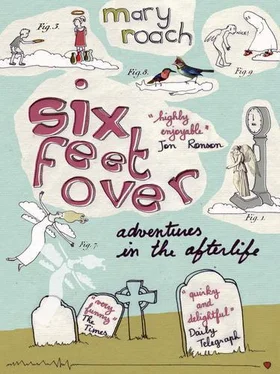Contemporary rabbinical discussion of the luz is harder to come by. On the website Ask the Rabbi, a mohel from Paris posted an e-mail seeking information about the luz. The rabbi’s reply confirmed the bone’s alleged indestructibility and added that it has been described as “having within it many intertwined spider-like blood vessels.” He referred the mohel to a Dr. Eli Temstet of Paris for more information. I e-mailed the mohel to see what he’d found out. “Dr. Eli Temstet of Paris has gone to a better world,” came the reply. “Now, he sure knows where and what exactly is the luz.” I sent an e-mail to Ask the Rabbi. Was there a paper on the spider-like blood vessels of the luz? The rabbi did not Answer the Writer. I consulted a book on Talmudic medicine, but no mention was made of the spidery veins of the soul bone. [7] My disappointment was short-lived, for this was a wondrous book. Here were detailed rabbinical opinions upon “whether or not a cattle breeder whose animal caused damage by knocking something with its penis must make restitution” (undecided); upon the inadmissibility of cleansing the anus “with the snout of a dog”; upon “the misconduct in which a woman places into the vagina of another woman a piece of meat from a fallen animal.” Here were descriptions of “hairy heart” and treatments for chronic uterine bleeding (“take three measures of Persian onions, boil them in wine, make her drink it and say to her, ‘Cease your discharge!’”).
The very first person to poke around for a soul in a human cadaver was the third-century B.C. physician Herophilus, of Alexandria. Herophilus is thought to be the first person in history to have dissected human cadavers for the purpose of scientific enlightenment. As such, he bagged a lot of anatomical discoveries. One of these was the four chambers, or ventricles, of the brain. He believed that the soul was headquartered in the fourth one. Why was Herophilus looking around for a soul inside a dead man, especially given that Egyptians believed in an afterworld [8] A rather barren place, from what I gather. Egyptians made frequent trips to the family plot to supply departed souls with food, clothing, and kitchen items. According to Clara Pinto-Correia, some tombs were even outfitted with toilet facilities for the ka (soul). That No. 2 carries over into the afterlife was apparently a common belief. Correia cites a reference to a funerary fragment expressing anxiety over the possibility that the ka, should its food cache run out, might resort to feeding on its excrement.
for souls to retire to? I can’t tell you for sure, but I can tell you that Herophilus was rumored to have dissected live humans as well. Two colleagues accused him of vivisecting hundreds of criminals. Perhaps his soul-related aspirations explain his poor table manners.
If your goal was to pinpoint the soul, it obviously made more sense to experiment on the living than on the dead. The simplest plan of action would be to systematically scramble, excise, or otherwise disable the likely structures and watch to see if the lights went out. And this, more or less, is what got done. Like Descartes, most scientists had zeroed in on the brain. (From early on, observations of personality changes caused by head injuries suggested a link between brain and self.) Galen was one of the earliest of the neuro-vivisectors; he experimented with cutting (and getting on) the nerves of his neighbors’ pigs. Based on this work, he decided that the soul was situated in the substance of the brain and not, as Herophilus had maintained, in the ventricles.
Leonardo da Vinci further narrowed it down. In 1996, McGill University professor of neurosurgery Rolando Del Maestro curated an exhibition called “Leonardo da Vinci: The Search for the Soul.” In the materials for the exhibit, Del Maestro describes a 1487 manuscript in which Leonardo made notes about a passage he had read in a book about the Carthaginian War. The passage describes the quickest way to kill an injured elephant: by pounding a stake between the animal’s ears at the top of the spinal column. Intrigued, Leonardo took to pithing frogs in a similar manner. “The frog instantly dies when its spinal medulla is perforated,” Del Maestro quotes Leonardo as having written. “And previously it lived without head, without heart or any interior organs, or intestines or skin. Here, therefore, it appears, lies the foundation of movement and life.” (I think that what he meant is that the skinned, gutted, headless, heartless frogs lived for a little while .)
Only one soul-seeking man of science carried out this sort of cavalier slice-and-see experimentation on a living human being. As the king’s surgeon and the founder of France’s Royal Academy of Surgery, Gigot de La Peyronie could pretty well do what he felt like. In 1741, he published a paper entitled “Observations by Which One Tries to Discover the Part of the Brain Where the Soul Exercises Its Functions.” The subject was a sixteen-year-old boy whose skull had been cracked by a rock. After three days of worsening symptoms, the youth fell unconscious. La Peyronie “opened up his head” and found a suppurating abscess deep down inside the brain, at the corpus callosum. He drained the wound, taking care to measure the runoff, which amounted to “about the volume of a hen’s egg.” As soon as the pus [9] I was intrigued to learn that the French for “pus”—even among members of eighteenth-century aristocracy—is “ le pus .”
that had weighed upon the corpus callosum was drained, he wrote, the coma lifted. La Peyronie noted that when the cavity had refilled with ooze, the youth fell unconscious again. He reemptied it, and again the boy awoke. The corpus callosum, he reasoned, must be the seat of the soul. Just to be sure, La Peyronie decided to undertake a little experiment. He filled a syringe with saline and injected it directly into the newly drained wound. As predicted, the boy lost consciousness. And was brought back to his senses when La Peyronie pumped the water back out.
La Peyronie found confirmation of his conclusions in three patients who had lost consciousness and died following head injuries and then been found during autopsy to have abscesses in the vicinity of the corpus callosum. One of the abscess pockets, that of a soldier whose horse had kicked him, was here again described as being “of the size and shape of a hen’s egg”—clearly the “bigger-than-a-breadbox” of its day.
Autopsies also enabled La Peyronie to rule out Descartes’s competing claim that the soul hung its hat in the pineal gland. La Peyronie had autopsied patients discovered to be missing the gland entirely or in whom it appeared to have petrified. “ Elle ne réside pas dans la glande pinéale,” he declared. I find a certain arrogance suffuses both La Peyronie’s writing and his deeds. If only he could know that today, as regards historic Frenchmen known to Americans, La Peyronie doesn’t hold a flame to Le Petomane, [10] I feel it would be wrong to introduce Le Petomane into a manuscript and then abandon him in the very same sentence. I had always thought that the act consisted of popular songs performed on his own wind instrument. But I learned from “The Straight Dope” columnist Cecil Adams that, in fact, Le Petomane, whose real name was Joseph Pujol, could produce only four notes without the aid of an ocarina. This is not to belittle his rectal talents. Pujol could smoke a cigarette down to its butt (or his butt, or both) and blow out candles, as well as expel a fountain of water several feet into the air.
the Moulin Rouge “fartiste,” whom no one should hold a flame to anyway.
La Peyronie was the last of a breed—a lone holdout in the anatomical search for the soul. Most of the early neuroanatomists had come to see that the self was too complex, too multifaceted, to be housed in or operated by a single biological entity. Like the Soviet Union after Gorbachev, the once broad and uniform-seeming soul began to splinter into dozens of smaller republics. Through a combination of unpleasant and often contradictory animal studies—living brains pokered, ablated, and hacked—and autopsy studies that sought to match brain abnormalities with dominant personality features, the men of science began mapping the specialized duties of the brain’s real estate, a project that continues to this day.
Читать дальше











